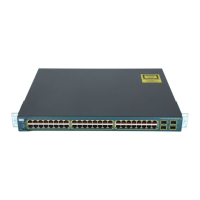32-11
Catalyst 3560 Switch Software Configuration Guide
78-16156-01
Chapter 32 Configuring IP Multicast Routing
Configuring IP Multicast Routing
To disable multicasting, use the no ip multicast-routing distributed global configuration command. To
return to the default PIM version, use the no ip pim version interface configuration command. To
disable PIM on an interface, use the no ip pim interface configuration command.
Configuring a Rendezvous Point
You must have an RP if the interface is in sparse-dense mode and if you want to treat the group as a sparse
group. You can use several methods, as described in these sections:
• Manually Assigning an RP to Multicast Groups, page 32-11
• Configuring Auto-RP, page 32-13 (a standalone, Cisco-proprietary protocol separate from PIMv1)
• Configuring PIMv2 BSR, page 32-17 (a standards track protocol in the Internet Engineering Task
Force (IETF)
You can use Auto-RP, BSR, or a combination of both, depending on the PIM version you are running
and the types of routers in your network. For more information, see the “PIMv1 and PIMv2
Interoperability” section on page 32-8 and the “Auto-RP and BSR Configuration Guidelines” section on
page 32-9.
Manually Assigning an RP to Multicast Groups
This section explains how to manually configure an RP. If the RP for a group is learned through a
dynamic mechanism (such as Auto-RP or BSR), you need not perform this task for that RP.
Senders of multicast traffic announce their existence through register messages received from the
source’s first-hop router (designated router) and forwarded to the RP. Receivers of multicast packets use
RPs to join a multicast group by using explicit join messages. RPs are not members of the multicast
group; rather, they serve as a meeting place for multicast sources and group members.
Step 5
ip pim {dense-mode | sparse-mode |
sparse-dense-mode}
Enable a PIM mode on the interface.
By default, no mode is configured.
The keywords have these meanings:
• dense-mode—Enables dense mode of operation.
• sparse-mode—Enables sparse mode of operation. If you configure
sparse-mode, you must also configure an RP. For more information,
see the “Configuring a Rendezvous Point” section on page 32-11.
• sparse-dense-mode—Causes the interface to be treated in the mode
in which the group belongs. Sparse-dense-mode is the recommended
setting.
Note After you enable a PIM mode on the interface, the ip
mroute-cache distributed interface configuration command is
automatically entered for the interface and appears in the running
configuration.
Step 6
end Return to privileged EXEC mode.
Step 7
show running-config Verify your entries.
Step 8
copy running-config startup-config (Optional) Save your entries in the configuration file.
Command Purpose

